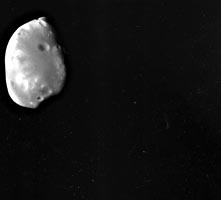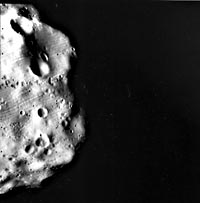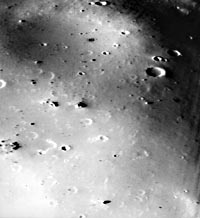 |
|---|
| Plate P-9 |
 |
|---|
| Plate P-9 |
The two natural satellites of Mars, Phobos (Flight) and Deimos (Fear), were so small that they were not discovered until 1877 by Asaph Hall. Their landforms are of interest in several respects. First, these are the smallest objects, with mean diameters of 21 km for Phobos and 13 km for Deimos, as yet given a close look. Second, and the consequence of this small size, these bodies have so little mass that landforms have developed in the near absence of gravity; at the surface of Deimos, for example, the acceleration due to gravity is less than 0.1 percent that of the Earth. Third, the densities of both bodies combined with their low albedos virtually dictate a carbonaceous chondrite composition; these are therefore landforms on very primitive undifferentiated bodies. Finally, several lines of evidence strongly suggest that these "satellites" are actually captured asteroids, giving us a preview of asteroid geomorphology.
Plate P-9 shows Phobos as imaged by a Viking Orbiter from 612-km range (Carr, 1982); Figure P-9.1 shows Deimos as seen from 948-km range. Perhaps the most obvious geomorphic characteristic is the first-order one of shape: both are rough triaxial ellipsoids. Beyond that, both are heavily cratered. According to P. Thomas, cited by Carr (1981), their depth/diameter ratios and relative rim heights are similar to those of lunar craters, suggesting that, for impact craters in this size range, gravity has minor influence on shape. All the craters visible on both bodies are simple, without central peaks or multiple concentric rims. Although this may reflect the low gravity, it is more likely a simple function of size; Carr points out that, on the Moon, such features are found only in craters wider than about 20 km, and such craters obviously cannot be found on Phobos and Deimos. The largest crater on Phobos, Stickney (facing the viewer), is about 10 km wide; formation of a larger crater probably would have broken the satellite into pieces.
Probably the most puzzling landforms on Phobos are the grooves and crater chains shown in Plate P-9 and Figure P-9.2. Features of this sort on the Moon would be explained as tectonic or volcanic, probably both, but essentially internal in origin. It is hard to imagine internal activity in a body only 21 km wide, especially one of carbonaceous chondrite composition, and the most likely explanation is that they were formed by the impact that produced the crater Stickney. The main evidence for this is simply that, when mapped globally (or perhaps one should say ellipsoidally) the grooves are seen to radiate from Stickney, converging on the antipode. P. Thomas (1979) has examined these grooves and has concluded that their distribution and morphology suggest that they are essentially impact fractures. These fractures may have been modified by collapsing into them or by ejection of impact-generated steam-both processes that could produce chains of craters. Because carbonaceous chondrites contain several percent water of crystallization, impact-stimulated volcanism of some kind is conceivable.
| Figure P-9.1 | Figure P-9.2 |
|---|---|
 |
 |
Whatever their origin, the grooves on Phobos present a fascinating geomorphic puzzle, one for which the most promising approach thus far seems to have been basic geologic (or photogeologic) mapping.
Another puzzling geomorphic characteristic of these small worlds is what appears to be thick regoliths on each, "thick" meaning 5 to 10 m for Deimos (Figure P-9.3) and up to 100 m for Phobos (Thomas, 1979). Formation of a regolith on heavily impacted bodies is now fairly well understood, owing to the Apollo investigations of the Moon. The dense crater population of the satellites of Mars clearly implies that regolith-forming processes have been active, but one would expect most of the ejecta from impact craters to be blown completely off because of the low gravity. However, the subdued outlines of craters and grooves (the latter on Phobos) imply that these are not bare rock surfaces, but are blanketed with debris.
Another enigmatic aspect of the regoliths is that the debris on Deimos appears to be more effective in subduing crater outlines than that on Phobos, suggesting that it may be thicker. From albedo markings on Deimos, Thomas has further shown that, despite the almost negligible surface gravity, mass wasting has taken place. Shaking by impacts or temperature changes may trigger creep; in any event, it is surprising to see gravity-dependent geomorphic processes at work even on this small satellite.
| Figure P-9.3 |
|---|
 |
To summarize this description of geomorphology on Phobos and Deimos, these satellites furnish us with an end member, so to speak, in the family of solid bodies in the solar system. They are among the smallest ones for which high-resolution images have been obtained; they are geochemically primitive undifferentiated bodies that are probably close to carbonaceous chondrites in composition; and they have evolved geomorphically almost entirely by external processes. It is both surprising and gratifying that our understanding of planetary geomorphology is now great enough to provide at least plausible, though incomplete, accounts of how these strange small planetary bodies have evolved. Viking Orbiter P20776.
Continue to Plate P-10| Chapter 10 Table of Contents.| Return to Home Page| Complete Table of Contents|